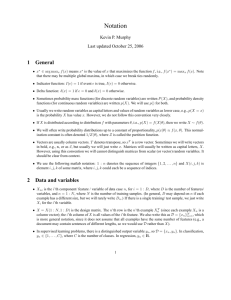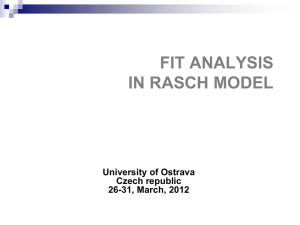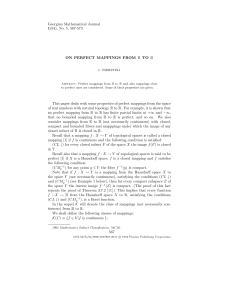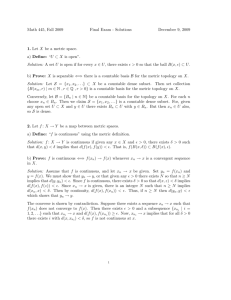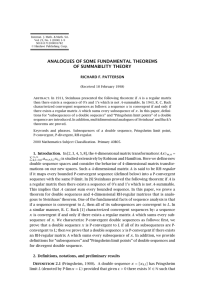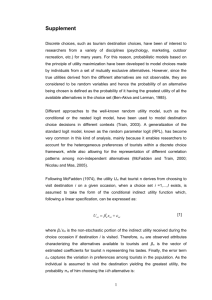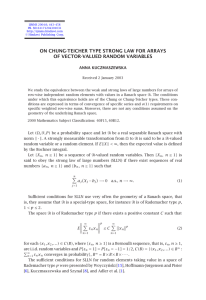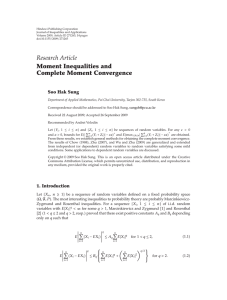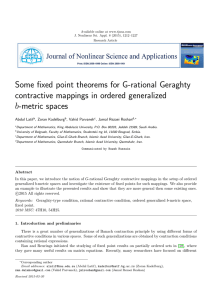Internat. J. Math. & Math. Sci. S0161171200003112 ©Hindawi Publishing Corp.
advertisement
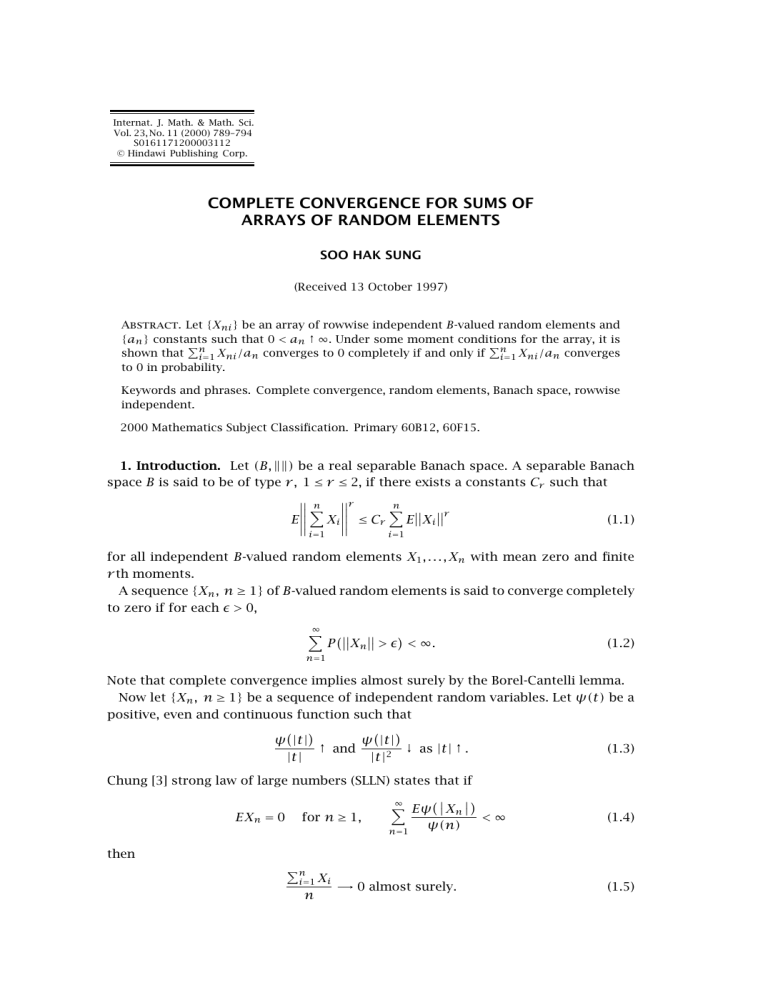
Internat. J. Math. & Math. Sci.
Vol. 23, No. 11 (2000) 789–794
S0161171200003112
© Hindawi Publishing Corp.
COMPLETE CONVERGENCE FOR SUMS OF
ARRAYS OF RANDOM ELEMENTS
SOO HAK SUNG
(Received 13 October 1997)
Abstract. Let {Xni } be an array of rowwise independent B-valued random elements and
{an } constants such that 0 < an ↑ ∞. Under some moment conditions for the array, it is
n
shown that n
i=1 Xni /an converges to 0 completely if and only if
i=1 Xni /an converges
to 0 in probability.
Keywords and phrases. Complete convergence, random elements, Banach space, rowwise
independent.
2000 Mathematics Subject Classification. Primary 60B12, 60F15.
1. Introduction. Let (B, ) be a real separable Banach space. A separable Banach
space B is said to be of type r , 1 ≤ r ≤ 2, if there exists a constants Cr such that
n
n
r
r
E
Xi ≤ Cr
E Xi (1.1)
i=1
i=1
for all independent B-valued random elements X1 , . . . , Xn with mean zero and finite
r th moments.
A sequence {Xn , n ≥ 1} of B-valued random elements is said to converge completely
to zero if for each > 0,
∞
P Xn > < ∞.
(1.2)
n=1
Note that complete convergence implies almost surely by the Borel-Cantelli lemma.
Now let {Xn , n ≥ 1} be a sequence of independent random variables. Let ψ(t) be a
positive, even and continuous function such that
ψ |t|
ψ |t|
↑ and
↓ as |t| ↑ .
(1.3)
|t|
|t|2
Chung [3] strong law of large numbers (SLLN) states that if
EXn = 0
then
for n ≥ 1,
∞
Eψ Xn <∞
ψ(n)
n=1
(1.4)
n
i=1 Xi
n
→ 0 almost surely.
(1.5)
790
SOO HAK SUNG
Recently, Hu and Taylor [6] proved Chung type SLLN for arrays of rowwise independent random variables. More specifically, let {Xni , 1 ≤ i ≤ n, n ≥ 1} be an array
of rowwise independent random variables and let {an , n ≥ 1} be a sequence of real
numbers with 0 < an ↑ ∞. Let ψ(t) be a positive, even and continuous function such
that
ψ |t|
ψ |t|
↑ and
↓ as |t| ↑
(1.6)
|t|p
|t|p+1
for some integer p ≥ 2. Furthermore, assume that
EXni = 0
for 1 ≤ i ≤ n, n ≥ 1,
Eψ Xni < ∞,
ψ an
n=1 i=1
2k
∞
n
2
EXni
< ∞,
a2n
n=1 i=1
∞
(1.7)
n
(1.8)
(1.9)
where k is a positive integer. Then the conditions (1.6), (1.7), (1.8), and (1.9) imply
n
1 Xni → 0 almost surely.
an i=1
(1.10)
Many classical theorems hold for B-valued random elements under the assumption that the weak law of large numbers (WLLN) holds (see, Kuelbs and Zinn [8], de
Acosta [4], Choi and Sung [1, 2], Wang, Rao and Yang [10], Kuczmaszewska and Szynal
[7], and Sung [9]).
In this paper, we apply de Acosta [4] inequality to obtain Hu and Taylor’s [6] result
in a general Banach space under the assumption that WLLN holds.
2. Main Result. To prove our main theorem, we need the following lemma which
is due to de Acosta [4].
Lemma 2.1. For each p ≥ 1, there exists a positive constant Cp such that for separable Banach space B and any finite sequence {Xi , 1 ≤ i ≤ n} of independent B-valued
random elements with EXi p < ∞ (1 ≤ i ≤ n), the following inequalities hold.
(i) For 1 ≤ p ≤ 2,
n
n
n
p
p
Xi − E Xi ≤ Cp
E Xi .
(2.1)
E i=1
i=1
i=1
(ii) For p > 2,
n
n
n
n
p
2 p/2 p
E Xi − E Xi ≤ Cp
E Xi
+
E Xi .
i=1
i=1
i=1
Throughout this paper, let ψ(t) be a positive, even function such that
ψ |t|
ψ |t|
↑ and
↓ as |t| ↑
|t|
|t|p
for some p ≥ 1.
(2.2)
i=1
(2.3)
COMPLETE CONVERGENCE FOR SUMS OF ARRAYS OF . . .
791
Theorem 2.2. Let {Xni , 1 ≤ i ≤ n, n ≥ 1} be an array of rowwise independent
B-valued random elements and {an , n ≥ 1} constants such that 0 < an ↑ ∞. Assume
that
n
∞ Eψ Xni < ∞,
ψ an
n=1 i=1
2 s
∞
n
E Xni <∞
a2n
n=1 i=1
(2.4)
(2.5)
for some s > 0. Then the following statements are equivalent.
n
(i) (1/an ) i=1 Xni → 0 in L1 .
n
(ii) (1/an ) i=1 Xni → 0 completely.
n
(iii) (1/an ) i=1 Xni → 0 almost surely.
n
(iv) (1/an ) i=1 Xni → 0 in probability.
Proof. (i) ⇒(ii). Define Yni = Xni I(Xni ≤ an ) and Zni = Xni I(Xni > an ). Since
ψ(|t|)/|t| is an increasing function of |t|, we have by (2.4) that
n
n
∞
∞
1 1 E
Zni ≤
E Zni a
a
n=1 n
n=1 n i=1
i=1
n
n
∞ Eψ Xni 1
≤
< ∞.
Eψ Zni ≤
ψ an i=1
ψ an
n=1
n=1 i=1
∞
(2.6)
It follows that
n
1 Zni → 0 completely.
an i=1
(2.7)
The proof will be completed by showing that
n
1 Yni → 0 completely.
an i=1
(2.8)
From (i) and (2.6), we have
n
n
1 1 E
Yni =
E
Xni − Zni an an i=1
i=1
n
n
1 1 ≤
E
Xni +
E
Zni → 0.
an an i=1
(2.9)
i=1
Thus, to prove (2.8), it is enough to show that
n
n
1 1 Yni −
E
Yni → 0 completely.
an i=1
an
i=1
(2.10)
First consider the case of 1 ≤ p ≤ 2. From Markov’s inequality and Lemma 2.1(i), we
have
792
SOO HAK SUNG
n
n
∞
1 1 P Yni −
E
Yni > an an n=1
i=1
i=1
n
p
∞
n
1 1 Yni − E Yni ≤ p
p E
n=1 an i=1
i=1
p
∞ n
∞ n
Cp E Yni Cp Eψ Yni ≤ p
≤ p
p
n=1 i=1
n=1 i=1 ψ an
an
n
∞
Cp Eψ Xni < ∞,
≤ p
n=1 i=1 ψ an
(2.11)
since ψ(|t|)/|t|p ↓ and (2.4). Thus (2.10) holds.
Now consider the case of p > 2. Note that ψ(|t|)/|t|p ↓ implies ψ(|t|)/|t|q ↓ for each
q ≥ p. Let q = max{p, 2s}. Then we have by Markov’s inequality and Lemma 2.1(ii) that
n
n
∞
1 1 P Yni −
E
Yni > an an n=1
i=1
i=1
q
∞
n
n
1 1 Yni − E Yni ≤ q
q E
an n=1
∞
i=1
i=1
q/2
n
2
q
1
E Yni +
E Yni q
a
n=1 n
i=1
i=1
n
2 q/2
n
∞
∞
q
Cq Cq 1 i=1 E Yni
= q
+
E Yni .
q
n=1
q n=1 an i=1
a2n
Cq
≤ q
n
Since q ≥ p, ψ(|t|)/|t|p ↓ implies ψ(|t|)/|t|q ↓, and so
n
n
n
∞
∞ ∞ Eψ Yni Eψ Xni 1 Yni q ≤
≤
< ∞.
E
q
ψ an
ψ an
a
n=1 n i=1
n=1 i=1
n=1 i=1
(2.12)
(2.13)
Also,
∞
n=1
n
i=1 E
Yni 2 q/2
a2n
≤
∞
n
i=1 E
Yni 2 s
a2n
n
2 s
∞
i=1 E Xni
2
an
n=1
q/2s
n=1
≤
(2.14)
q/2s
< ∞,
since q ≥ 2s and (2.5). Combining (2.12), (2.13), and (2.14) yields (2.10). Thus (i) ⇒(ii)
is proved. Since the implications (ii) ⇒(iii) and (iii) ⇒(iv) are obvious, it remains to
show that (iv) ⇒(i).
Assume that (iv) holds. From Lemma 2.1(i) and (2.5)
n
n
2
n
1 2
C2 1 Xni −
E
Xni ≤ 2
E Xni → 0,
(2.15)
E
an an a
n
i=1
i=1
i=1
which entails
n
n
1 1 Xni −
E
Xni → 0 in probability.
an an i=1
i=1
(2.16)
COMPLETE CONVERGENCE FOR SUMS OF ARRAYS OF . . .
793
n
It follows by (iv) that E i=1 Xni /an → 0, and so (i) holds. Thus the proof of
Theorem 2.2 is completed.
The following theorem states that Theorem 2.2 holds even if the condition (2.5) is
replaced by
n ∞
E Xni r s
< ∞,
(2.17)
arn
n=1 i=1
for some 1 ≤ r ≤ 2 and s > 0.
Theorem 2.3. Let {Xni , 1 ≤ i ≤ n, n ≥ 1} be an array of rowwise independent
B-valued random elements and {an , n ≥ 1} constants such that 0 < an ↑ ∞. Assume
that (2.4) and (2.17) hold. Then the following statements are equivalent.
n
(i) (1/an ) i=1 Xni → 0 in L1 .
n
(ii) (1/an ) i=1 Xni → 0 completely.
n
(iii) (1/an ) i=1 Xni → 0 almost surely.
n
(iv) (1/an ) i=1 Xni → 0 in probability.
Proof. Let {Yni } and {Zni } be as in the proof of Theorem 2.2. From the proof of
(i) ⇒(ii) in Theorem 2.2, we have
n
∞
1 E
Zni < ∞,
(2.18)
an n=1
i=1
n
which implies i=1 Zni /an → 0 in L1 , completely, almost surely, and in probability.
Hence, it is enough to show that
n
n
1 1 Yni → 0 in L1 ⇐⇒
Yni → 0 completely
an i=1
an i=1
⇐⇒
n
1 Yni → 0 almost surely
an i=1
⇐⇒
n
1 Yni → 0 in probability.
an i=1
Since Yni = Xni I(Xni ≤ an ), it follows that Eψ(Yni ) ≤ Eψ(Xni ) and
n n n ∞
∞
∞
E Yni 2 s
E Yni r s
E Xni r s
≤
≤
.
arn
arn
a2n
n=1 i=1
n=1 i=1
n=1 i=1
(2.19)
(2.20)
Thus {Yni } satisfies the conditions of Theorem 2.2, and so (2.19) holds by Theorem 2.2.
Corollary 2.4. Let {Xni , 1 ≤ i ≤ n, n ≥ 1} be an array of rowwise independent
B-valued random elements and {an , n ≥ 1} constants such that 0 < an ↑ ∞. Assume
that EXni = 0 and B is of type r (1 ≤ r ≤ 2). Then (2.4) and (2.17) imply that
n
1 Xni → 0 almost surely.
an i=1
(2.21)
794
SOO HAK SUNG
Proof. By Theorem 2.3, it is enough to show that
n
1 Xni → 0 in L1 .
an i=1
(2.22)
Since B is of type r and EXni = 0, it follows by (2.17) that
r
n
n
1 r
Cr E
Xni ≤ r
E Xni → 0,
an
an i=1
i=1
(2.23)
and so (2.22) holds.
Remark 2.5. The condition (2.3) is weaker than (1.6). Hu and Chung [5] proved
Corollary 2.4 under the stronger condition (1.6).
References
[1]
[2]
[3]
[4]
[5]
[6]
[7]
[8]
[9]
[10]
B. D. Choi and S. H. Sung, On Chung’s strong law of large numbers in general Banach spaces, Bull. Austral. Math. Soc. 37 (1988), no. 1, 93–100. MR 89b:60018.
Zbl 628.60012.
, On Teicher’s strong law of large numbers in general Banach spaces, Probab. Math.
Statist. 10 (1989), no. 1, 137–142. MR 90f:60013. Zbl 686.60007.
K. L. Chung, Note on some strong laws of large numbers, Amer. J. Math. 69 (1947), 189–
192. MR 8,471a. Zbl 034.07103.
A. de Acosta, Inequalities for B-valued random vectors with applications to the strong
law of large numbers, Ann. Probab. 9 (1981), no. 1, 157–161. MR 83c:60009.
Zbl 449.60002.
T. C. Hu and H. C. Chang, Strong laws of large numbers for arrays of random elements,
Soochow J. Math. 20 (1994), no. 4, 587–594. MR 95k:60012. Zbl 861.60014.
T. C. Hu and R. L. Taylor, On the strong law for arrays and for the bootstrap mean and
variance, Internat. J. Math. Math. Sci. 20 (1997), no. 2, 375–382. MR 97k:60011.
Zbl 883.60024.
A. Kuczmaszewska and D. Szynal, On complete convergence in a Banach space, Internat.
J. Math. Math. Sci. 17 (1994), no. 1, 1–14. MR 95d:60012. Zbl 798.60006.
J. Kuelbs and J. Zinn, Some stability results for vector valued random variables, Ann.
Probab. 7 (1979), no. 1, 75–84. MR 80h:60014. Zbl 399.60007.
S. H. Sung, Complete convergence for weighted sums of arrays of rowwise independent B-valued random variables, Stochastic Anal. Appl. 15 (1997), no. 2, 255–267.
MR 98c:60007. Zbl 902.60011.
X. C. Wang, M. B. Rao, and X. Y. Yang, Convergence rates on strong laws of large numbers
for arrays of rowwise independent elements, Stochastic Anal. Appl. 11 (1993), no. 1,
115–132. MR 94a:60007. Zbl 764.60037.
Sung: Department of Applied Mathematics, Pai Chai University, Taejon 302-735,
South Korea
E-mail address: sungsh@mail.paichai.ac.kr
